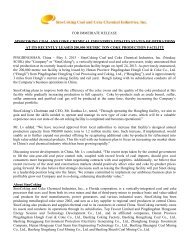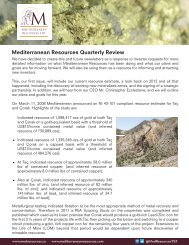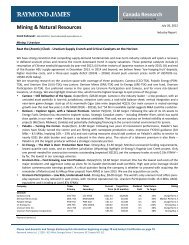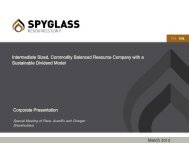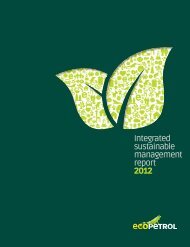Annual Report 2012
Annual Report 2012
Annual Report 2012
- No tags were found...
Create successful ePaper yourself
Turn your PDF publications into a flip-book with our unique Google optimized e-Paper software.
Notes to the financial statements(Expressed in millions of RMB, unless otherwise stated)4 Significant accounting policies and accounting estimates (continued)(3) Financial instruments (continued)(b) Derivatives and embedded derivativesThe Group uses derivatives to hedge its exposure to foreign exchange and interest rate risks. Derivatives are recognised at fairvalue upon initial recognition. The positive fair value is recognised as an asset while the negative fair value is recognised as aliability. The gain or loss on re-measurement to fair value is recognised in profit or loss.Certain derivatives are embedded into non-derivative hybrid instruments (the host contracts). The embedded derivatives areseparated from the host contract and accounted for as a separate derivative when (i) the economic characteristics and risksof the embedded derivative are not closely related to the host contract; (ii) a separate instrument with the same terms as theembedded derivative would meet the definition of a derivative; and (iii) the hybrid (combined) instrument is not measured at fairvalue with changes in fair value recognised in profit or loss. When the embedded derivative is separated, the host contract isaccounted for as a financial instrument in accordance with the accounting policies as set out in Note 4(3).(c)Recognition and derecognitionAll financial assets and financial liabilities are recognised in the statement of financial position, when and only when, the Groupbecomes a party to the contractual provisions of the instrument.The Group derecognises a financial asset if the part being considered for derecognition meets one of the following conditions:(i) the contractual rights to receive the cash flows from the financial asset expire; (ii) the contractual rights to receive the cashflows of the financial asset have been transferred and the Group transfers substantially all the risks and rewards of ownershipof the financial asset; or (iii) the Group retains the contractual rights to receive the cash flows of the financial asset, butassumes a contractual obligation to pay the cash flows to the eventual recipient in an agreement that meets all the conditionsof transfer of cash flows and transfers substantially all the risks and rewards of ownership of the financial asset.The difference between the carrying amount of the financial asset derecognised and the consideration received and thecumulative changes in fair value previously recognised in equity are recognised in profit or loss.If the Group neither transfers nor retains substantially all the risks and rewards of ownership of the financial asset, but retainscontrol, the Group continues to recognise the financial asset to the extent of its continuing involvement in the financial asset.If the Group has not retained control, it derecognises the financial asset and recognises separately as assets or liabilities anyrights and obligations created or retained in the transfer.The financial liability is derecognised only when: (i) the underlying present obligation specified in the contracts is discharged,cancelled or expired, or (ii) an agreement between the Group and an existing lender to replace the original financial liability witha new financial liability with substantially different terms, or a substantial modification of the terms of an existing financial liabilityis accounted for as an extinguishment of the original financial liability and recognition of a new financial liability.The difference between the carrying amount of the financial liability derecognised and the consideration paid is recognised inprofit or loss.(d)MeasurementFinancial instruments are measured initially at fair value plus, in the case of a financial instrument not at fair value throughprofit or loss, transaction costs that are directly attributable to the acquisition or issue of the instrument. Transaction costs forfinancial instruments at fair value through profit or loss are expensed immediately.Subsequent to initial recognition, held-to-maturity investments, loans and receivables and other financial liabilities are measuredat amortised cost, while other categories of financial instruments are measured at fair value, without any deduction fortransaction costs that may occur on sale or other disposal. Investments in available-for-sale equity instruments that do not havea quoted market price in an active market and whose fair value cannot be reliably measured, and derivatives that are linked toand must be settled by delivery of such unquoted equity instruments are measured at cost less impairment losses, if any.Gains and losses from changes in the fair value of financial instruments at fair value through profit or loss are recognised inprofit or loss.Unrealised gains and losses arising from changes in the fair value of available-for-sale financial assets are recognised in othercomprehensive income and accumulated separately in equity, except for impairment losses and foreign exchange gains andlosses on monetary items such as debt securities which are recognised in profit or loss.When the available-for-sale financial assets are sold, gains or losses on disposal are recognised in profit or loss. Gains orlosses on disposal include those previously recognised in other comprehensive income and reclassified into the profit or loss.For financial assets and financial liabilities carried at amortised cost, a gain or loss is recognised in profit or loss when thefinancial asset or financial liability is derecognised, impaired, or through the amortisation process.China Construction Bank Corporation annual report <strong>2012</strong>103



